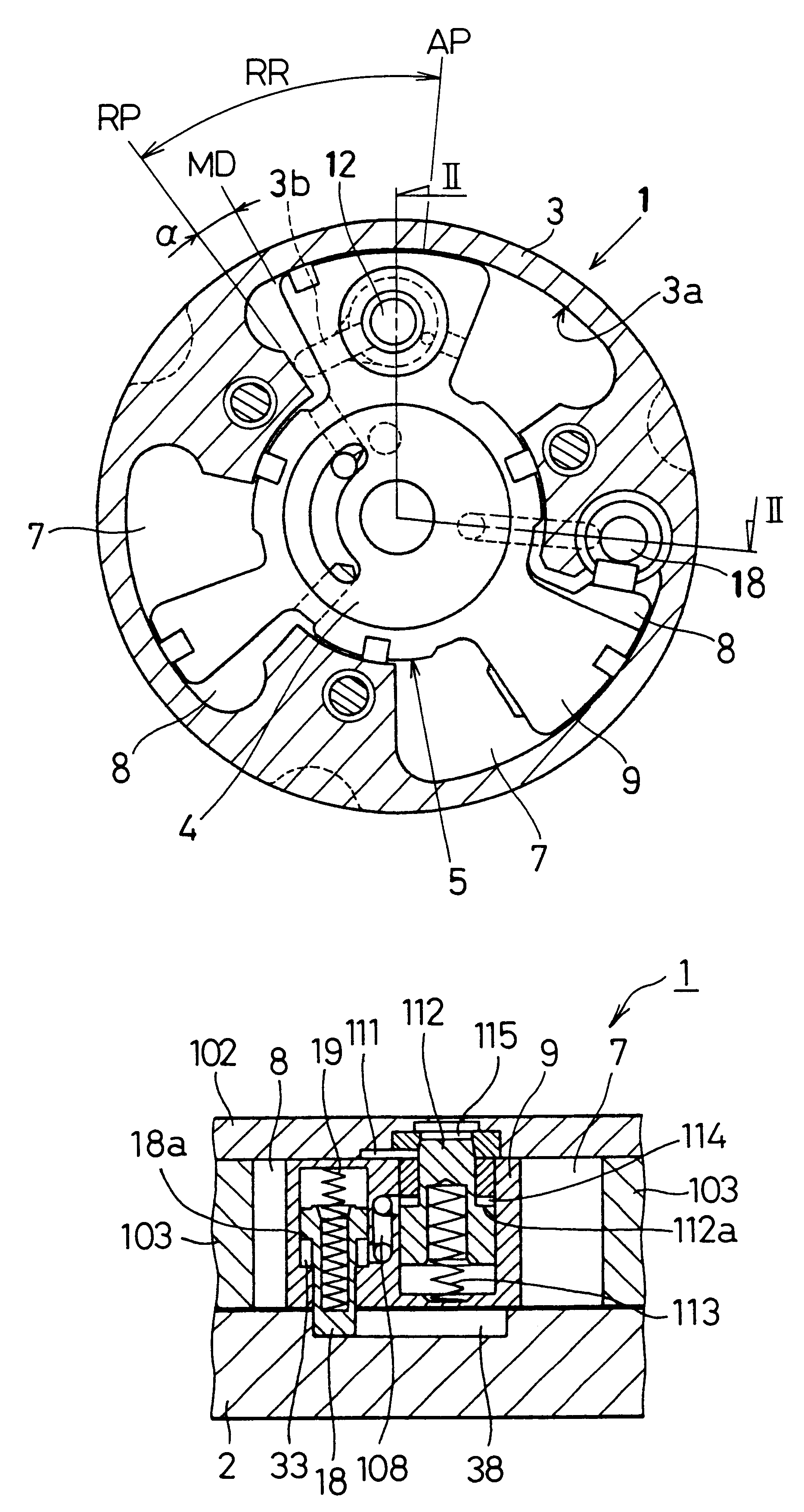Variable valve timing apparatus
a timing apparatus and variable valve technology, applied in mechanical equipment, valve arrangements, machines/engines, etc., can solve the problems of difficult engine starting, difficulty in ensuring the hydraulic pressure required to lock the rotor, and insufficient supply of hydraulic oil
- Summary
- Abstract
- Description
- Claims
- Application Information
AI Technical Summary
Benefits of technology
Problems solved by technology
Method used
Image
Examples
eleventh embodiment
FIG. 36 is a cross sectional view of a VVT 1 and FIG. 37 is a front view in the axial direction of the VVT 1. In the VVT 1 of the present embodiment, an exclusive oil passage 108 is formed in a bolt 110 for fixing a rotor 5 and a hydraulic control valve 105 for opening or closing the communication between the exclusive oil passage 108 and a drain space is fixed to the front side (left side of the case 3) of the VVT 1.
The exclusive oil passage 108, as shown in FIG. 36, communicates with an oil reservoir 117 made in a camshaft 4. An orifice 118 is disposed between the exclusive oil passage 108 and the oil reservoir 117. The exclusive oil passage 108 communicates with a lock depression 24 via a housing 3 side.
The hydraulic control valve 105 opens when an advance angle restricting pin 112 (which serves as a lock pin) is fitted in the lock depression 115 to lock the rotor 5 at the normal delay angle position and closes when the prevention of rotation of the rotor 5 by the advance angle r...
twelfth embodiment
FIG. 42 is a cross sectional view of the vicinity of an advance angle restricting pin 112 and a delay angle restricting pin 18. The present embodiment is an example in which an oil discharging port 120 and a pressure releasing port 121 are formed to eliminate the effect of the hydraulic pressure on the motion of the advance angle restricting pin 112. The pins 18, 112 are disposed to have operating direction opposite to the operating direction of the pins 18, 112 of the tenth embodiment. Here, since the basic constitution of the VVT is the same as in the tenth embodiment, the oil discharging port 120 and the pressure releasing port 121 will be described.
The oil discharging port 120 is an passage for discharging the hydraulic oil leaking to an advance angle restricting groove 111 from a hydraulic chamber (a delay angle chamber 7 and an advance angle chamber 8) and is formed in a sprocket 2, as shown in FIG. 42, to open a lock depression 115 made at the end portion of the advance angle...
thirteenth embodiment
FIG. 47 is a cross sectional view of the vicinity of an advance angle restricting pin 112 and a delay angle restricting pin 18, and FIG. 48 is a plan view of the advance angle restricting pin 112 with a sprocket 2 removed when viewed from the tip end side thereof. The present embodiment is an example in which a communication groove 124 for making an advance angle restricting groove 111 communicate with a control chamber 114 is formed in place of the oil discharging port 120 shown in the twelfth embodiment.
As shown in FIG. 47, in a vane 9 is incorporated a cylindrical bearing 125 for slidably locking the advance angle restricting pin 18. The inner circumferential surface of the bearing 125 is depressed to form the communication groove 124. The communication groove 124, as shown in FIG. 48, is formed between the bearing 125 and the advance angle restricting pin 18 in the direction nearly perpendicular to the rotational direction of the rotor 5. Since the hydraulic oil leaking to the a...
PUM
 Login to View More
Login to View More Abstract
Description
Claims
Application Information
 Login to View More
Login to View More - R&D
- Intellectual Property
- Life Sciences
- Materials
- Tech Scout
- Unparalleled Data Quality
- Higher Quality Content
- 60% Fewer Hallucinations
Browse by: Latest US Patents, China's latest patents, Technical Efficacy Thesaurus, Application Domain, Technology Topic, Popular Technical Reports.
© 2025 PatSnap. All rights reserved.Legal|Privacy policy|Modern Slavery Act Transparency Statement|Sitemap|About US| Contact US: help@patsnap.com



